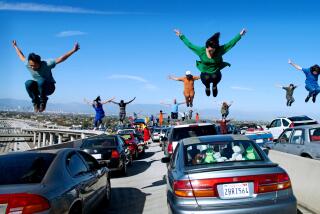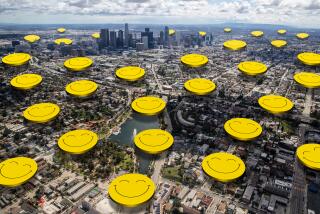Urban planning that’s more than child’s play
- Share via
Inspiration was flowing like the Verdugo Wash after a five-day rainstorm for Alex Dann.
“Where’s the zoo?” he asked, sizing up the table-size tableau in front of him. “Over there? Cool.”
The 7-year-old Tarzana boy was at a downtown Los Angeles art gallery Saturday, poring over an exhibit called “Five Models Afloat.” A moment later, he was participating in it.
He carefully studied the 4-foot foam-board square, which was divided into thirds by a bright blue plastic slash that depicted the Los Angeles River where it is joined by the Verdugo Wash at the Glendale-Los Angeles border.
One part of the square was covered by a miniature “mountain” molded out of window screen material to represent the Hollywood Hills. The other two, depicting flatland areas, were grids marked with a series of green swatches.
Dotting the areas around the swatches were tiny movable structures formed from small blocks of wood, Lego pieces, parts of toys and objects such as toothpaste caps.
Alex moved a wood-block figurine resembling a high-rise apartment house away from the edge of the river. He was asked if he had ever seen the real Los Angeles River and what it was like.
“Yeah, I’ve seen it. It’s a sewer,” he replied as his mother, Holly Dann, blanched.
“Well, it is,” Alex said, standing his ground.
The pair, along with father David Dann and 11-year-old sister Abby, had stopped at the gallery while shopping downtown.
The three-dimensional scene Alex was working on is a representation of one of five points along a 32-mile stretch of river for which officials have launched long-range plans to beautify the waterway and make it appear more natural.
Los Angeles officials, consultants and the Army Corps of Engineers spent two years conducting formal public workshops seeking ideas for the rehabilitation of what is now a mostly concrete-lined flood channel. Last month, they issued a draft report suggesting that a $2-billion makeover over the next 50 years could replace industrial land along the banks with park space. The steep concrete walls could be landscaped and rebuilt with step-like channelization.
There are professionally drawn maps and computergenerated renderings of what the future river could resemble. But it took transportation planner James Rojas to give it a threedimensional look.
Rojas, 47, works for the Metropolitan Transportation Authority. He is also co-owner of Gallery 727 in a storefront at 727 S. Spring St., where “Five Models Afloat” will end its monthlong run today with a final showing from noon to 4 p.m.
“As a planner, I go to a lot of meetings, and they’re always very boring because they’re flat and one-dimensional,” Rojas said. “A lot of people can’t read maps. By showing them three-dimensional models, it becomes a lot more engaging. You can figure out how the topography works. You can lean down and look at it and see how things relate to each other.”
The tiny blocks, figurines and other objects that gallery visitors use to create bridges, park plazas, town houses and shops are things that Rojas has collected since childhood.
Rojas said he planned the installation with children in mind, because the actual river renovation “will come in their lifetime, not ours.”
About 700 people have visited the exhibit, including design consultants working on the river plan and city officials. One of them was Councilman Ed Reyes, who heads the river master-planning committee.
“When I first heard about it, I thought it was unconventional, kind of strange. But when I got there, I saw people doing some creative things,” he said. “What struck me was how elaborate the little block and figurine structures were. People were really thinking about what they were doing.”
After watching awhile, Reyes tried some hands-on planning of his own.
“I felt kind of silly at first. But then I got to thinking: Where does the bridge go? Then I thought about decorating it with an angel, since the bridge was going to be near where the birthplace of the city was.
“Toward the end of my stay,” he said, “I saw a 6-year-old take over the whole board. And he did his own thing, and it didn’t look much different from what others were doing. He was laying down his vision as a young person.”
Reyes said professional planners welcome such creativity. Rojas agrees. So he has photographed various versions of the five river model boards as a permanent record of what visitors have suggested.
Some of the ideas are novel. One person used an acrylic toy lighthouse to mark the start of the river, where the Arroyo Calabasas and Bell Creek come together behind Canoga Park High School. Small plastic half-spheres illustrate “floating sticky balls” that another visitor placed at the juncture of the river and the Verdugo Wash “so people who fall in can stick to the balls and be saved.”
That’s the same area where Alex Dann installed his floating filter -- made up of several rubber gaskets and what appeared to be a silver-colored tube connector he found in one of Rojas’ supply boxes.
“This is a machine that sucks up the trash and stuff from the water,” the boy explained, dropping bits of paper onto the faux river to illustrate how it would work.
Gallery 727 co-owner Adrian Rivas nodded knowingly.
“You’re an urban planner now,” he told Alex.
*
More to Read
The biggest entertainment stories
Get our big stories about Hollywood, film, television, music, arts, culture and more right in your inbox as soon as they publish.
You may occasionally receive promotional content from the Los Angeles Times.











